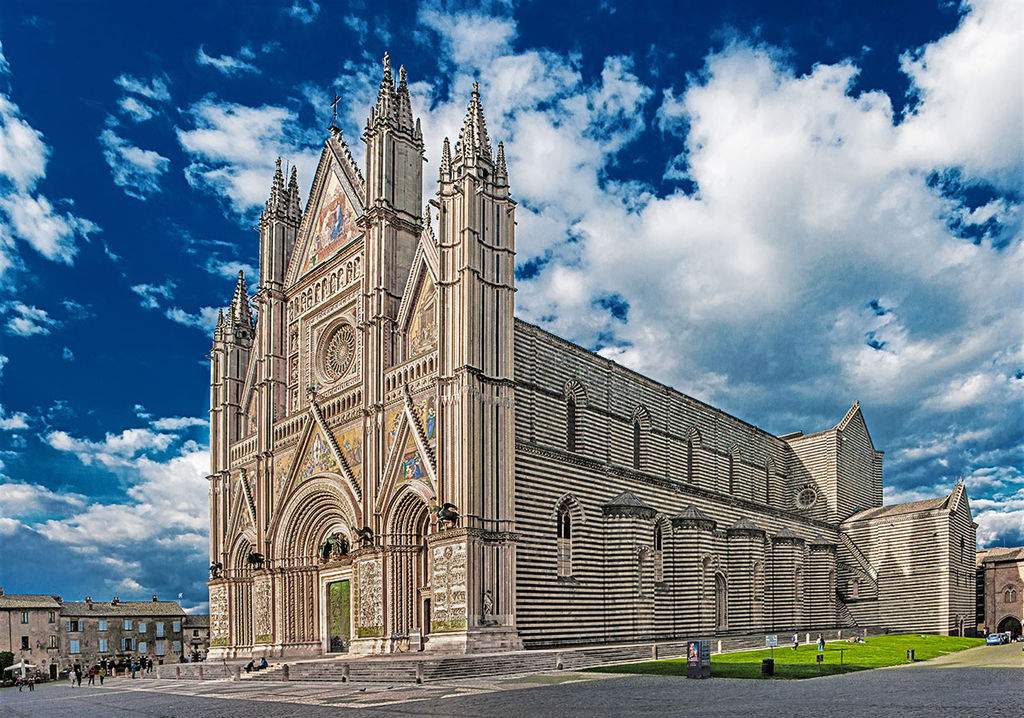Heat also damages monuments. Fragment of spire of Orvieto Cathedral collapses due to high temperatures
Global climate change threatens to threaten monuments as well: in fact, it seems that the heat and high temperatures of last week were to blame for the collapse of a portion of a cornice that affected the façade of Orvieto Cathedral, one of the country’s most extraordinary buildings of worship. Fortunately, the incident, which could have had tragic outcomes given that the fragments (which fell from one of the spires) fell to the ground from a height of forty meters, did not involve any people. What came off were basalt and travertine elements.
The event occurred on the evening of Wednesday, August 7, when temperatures were hovering around 34 degrees. Immediately after the collapse, the area of the square affected by the collapse was secured by the fire department. The problem now is trying to figure out exactly what the causes of the collapse were, and to understand whether a similar event could occur again in the future. “What happened technically we don’t know,” architect Mauro Stella of Orvieto’s Opera del Duomo told Il Messaggero newspaper. “First we have to reach with a basket the part and view it closely. We will do that in the coming days. The portion fell from the third cornice of the left spire, in the outer side. Certainly, the cathedral is exposed to the weather, and the temperature range due to these high temperatures could be the main cause of the small collapse.” The point is that the heat could have expanded the materials causing a crack, which would have caused the elements to come unglued causing them to fall.
On August 10, firefighters carried out an inspection with a drone, brought in by the drone nucleus of the La Spezia Fire Department: the objective of the operation is to gather information to have a precise diagnosis of what happened. Meanwhile, the cathedral remains open and tourists can continue to visit it. However, the area on which the fragment of the spire collapsed continues to be transennaded.
Orvieto Cathedral is one of the symbolic monuments of Italian Gothic architecture. It was built beginning in 1290 at the behest of Pope Nicholas IV and is notable for the interventions of the great architect Lorenzo Maitani (Siena, c. 1275 - Orvieto, 1330), who worked on it from the early fourteenth century and to whom we owe the layout of the façade that we still admire today. The interior is famous for the fact that it houses one of the great masterpieces of the Italian Renaissance: the frescoes of the Chapel of San Brizio begun by Beato Angelico (Vicchio, c. 1395 - Rome, 1455) with the help of Benozzo Gozzoli, and then finished in 1502 by Luca Signorelli (Cortona, c. 1450 - 1523), to whom we owe the most famous scenes.
In the photo: the Cathedral of Orvieto. Ph. Credit Claudio Caravano
 |
| Heat also damages monuments. Fragment of spire of Orvieto Cathedral collapses due to high temperatures |
Warning: the translation into English of the original Italian article was created using automatic tools. We undertake to review all articles, but we do not guarantee the total absence of inaccuracies in the translation due to the program. You can find the original by clicking on the ITA button. If you find any mistake,please contact us.



























